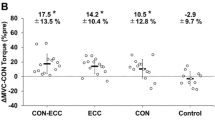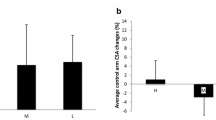Abstract
The purpose of this study was to show that velocity-specific training may be implicated in modifications in the level of coactivation of agonist and antagonist muscles. Healthy males (n = 20) were randomly placed in to two groups: one group trained using concentric contractions (n = 12), the other was an untrained control group (n = 8). The training group underwent unilateral resistance training at a level of 35 (5)% of a one-repetition maximal contraction of the elbow flexors, executed at maximal angular velocity. Training sessions consisted of six sets of eight consecutive elbow flexions, three times per weak for a total of seven weeks. The velocity of the ballistic movements executed during training were measured using an optoelectronic measuring device (Elite), both at the beginning and at the end of the training period. Subjects were tested pre- and post-training during isokinetic maximal elbow flexions with constant angular torque (CAT) at 90° (0° = full extension), and at different velocities (60, 120, 180, 240 and 300° · s−1) for concentric actions, and −60 and −30° · s−1 for eccentric and isometric contractions at 90°. In order to verify the levels of activation of the agonist biceps brachii (BB) muscles and antagonist triceps brachii (TB) muscles during maximal voluntary activation, their myoelectrical activities were recorded and quantified as root mean square (RMS) amplitudes, between angles of 75 and 105°. The results show that mean angular velocities between elbow angles of 75 and 105° were similar before [302 (32)° · s−1] and after [312 (27)° · s−1] the training period. CAT significantly increased measures at angular velocities of 240 and 300° · s−1 by 18.7% and 23.5%, respectively. The RMS activity of BB agonist muscles was not significantly modified by training. Post-training normalized RMS amplitudes of TB antagonist muscles were inferior to those observed at pre-training, but values were only significantly different at 300° · s−1. In conclusion, in this study we attempted to show that an increase of CAT to 240 and 300° · s−1, though velocity-specific training, may be due, in part, to a lowering of the level of coactivation.
Similar content being viewed by others
Author information
Authors and Affiliations
Additional information
Accepted: 15 March 1999
Rights and permissions
About this article
Cite this article
Pousson, M., Amiridis, I., Cometti, G. et al. Velocity-specific training in elbow flexors. Eur J Appl Physiol 80, 367–372 (1999). https://doi.org/10.1007/s004210050605
Issue Date:
DOI: https://doi.org/10.1007/s004210050605




